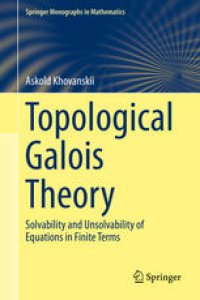
Ebook: Topological Galois Theory: Solvability and Unsolvability of Equations in Finite Terms
Author: Askold Khovanskii (auth.)
- Tags: Field Theory and Polynomials, Functions of a Complex Variable, Group Theory and Generalizations, Topological Groups Lie Groups, Several Complex Variables and Analytic Spaces, Topology
- Series: Springer Monographs in Mathematics
- Year: 2014
- Publisher: Springer-Verlag Berlin Heidelberg
- Edition: 1
- Language: English
- pdf
This book provides a detailed and largely self-contained description of various classical and new results on solvability and unsolvability of equations in explicit form. In particular, it offers a complete exposition of the relatively new area of topological Galois theory, initiated by the author. Applications of Galois theory to solvability of algebraic equations by radicals, basics of Picard–Vessiot theory, and Liouville's results on the class of functions representable by quadratures are also discussed.
A unique feature of this book is that recent results are presented in the same elementary manner as classical Galois theory, which will make the book useful and interesting to readers with varied backgrounds in mathematics, from undergraduate students to researchers.
In this English-language edition, extra material has been added (Appendices A–D), the last two of which were written jointly with Yura Burda.
This book provides a detailed and largely self-contained description of various classical and new results on solvability and unsolvability of equations in explicit form. In particular, it offers a complete exposition of the relatively new area of topological Galois theory, initiated by the author. Applications of Galois theory to solvability of algebraic equations by radicals, basics of Picard–Vessiot theory, and Liouville's results on the class of functions representable by quadratures are also discussed.
A unique feature of this book is that recent results are presented in the same elementary manner as classical Galois theory, which will make the book useful and interesting to readers with varied backgrounds in mathematics, from undergraduate students to researchers.
In this English-language edition, extra material has been added (Appendices A–D), the last two of which were written jointly with Yura Burda.